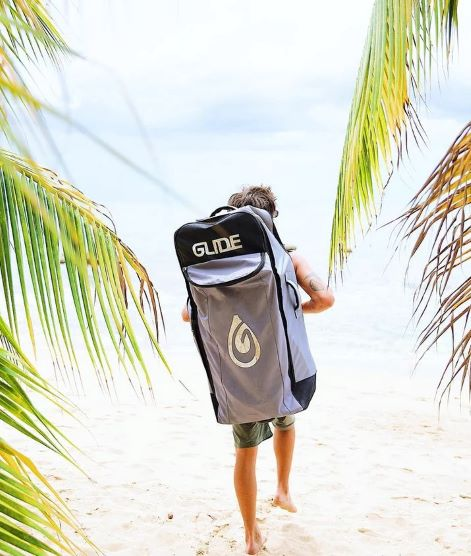
Inflatable SUPs for Beginners: Why They Make It Easy
Inflatable SUPs make it easy to start paddleboarding thanks to their stability, durability, and portability. Learn what to look for, which Glide models fit beginners best, and how to start your SUP adventure with confidence and ease.
Inflatable SUPs for beginners make paddling simple—stable, durable, and easy to transport.
Learn ideal sizes, must-have features, and starter tips so your first sessions feel confident and fun.
Table of contents
If you’re new to stand-up paddleboarding (SUP), one of the first decisions you’ll make is choosing the right board. For most beginners, inflatable paddle boards are not just a good starting point—they’re the best one.
Inflatable SUPs offer unmatched stability, portability, and value, making them ideal for anyone looking to get on the water with confidence. Let’s explore why these boards are perfect for beginners, what features to look for, and which Glide models can help you launch your SUP journey with ease.

Why Inflatable SUPs Are Ideal for Beginners
Inflatable paddle boards—often called iSUPs—combine performance, comfort, and practicality. Here’s why they’re especially suited for newcomers:
1. Unmatched Portability
Inflatable SUPs roll up and fit in a backpack, making them easy to transport and store. Whether you’re heading to a nearby lake or traveling in a compact car, you can bring your board anywhere adventure calls.
2. Durability You Can Rely On
Despite the name, inflatable boards are incredibly tough. Glide’s military-grade PVC, triple-layer ThermoFuse™ Rails, and AeroMatrix™ cross-woven drop-stitch cores make each board ultra-rigid and ready for real-world paddling—from rocky shores to playful dogs onboard.
3. Beginner-Friendly Stability
Inflatable boards are often wider than traditional hard boards, offering a forgiving, steady platform to practice on. That extra stability makes it easier to stand, paddle, and gain confidence on the water.
4. Comfort and Safety
The soft, cushioned deck pad offers secure traction without the harshness of fiberglass. It’s gentle if you fall and comfortable for long paddling sessions—or when sharing your board with a child or pet.

Choosing Your First Inflatable Paddle Board
Your first board sets the tone for your paddling experience. Here’s what to prioritize:
Board Size:
Boards around 10’6” to 11’6” long and 32–34” wide are ideal for beginners. The length helps with glide and tracking, while the width gives you extra balance.
Weight Capacity:
Opt for boards with at least 350 lbs of weight capacity. Even if you’re lighter, this ensures stability when carrying gear, a pet, or a friend.
Construction:
Choose woven or cross-woven drop-stitch cores (like AeroMatrix™) for stiffness and durability. Glide’s ThermoFuse™ triple-layer rails ensure a solid, long-lasting build.
Pump and Inflation System:
Dual-action hand pumps or electric pumps make setup easy and fast—Glide boards inflate in about ten minutes or less.
Included Accessories:
Beginners benefit from complete packages that include:
-
Adjustable paddle
-
Coiled leash
-
Kayak seat conversion
-
Backpack (ideally with wheels)
-
Pump
-
Repair kit
Top Glide Picks for First-Time Paddlers
Glide O2 Retro
The O2 Retro is the ultimate all-around board for new paddlers. It’s stable, durable, and easy to paddle, with AeroMatrix™ rigidity and ThermoFuse™ rails for long-term reliability. The package includes everything you need to get on the water—from paddle and leash to a kayak conversion seat.
Glide Lotus
If balance and comfort are top priorities, the Lotus is designed for stability and relaxation. With a wide deck and soft traction pad, it’s perfect for beginners, yoga sessions, or peaceful paddles.
Glide Quest & Wander
For those who want to progress quickly or paddle longer distances, the Quest and Wander offer a touch more speed while maintaining beginner-friendly stability. Great for paddlers ready to explore beyond calm lakes.
Getting Started: Tips for First-Time Paddlers
-
Start in Calm Water: Choose a small lake, pond, or protected bay. Avoid windy conditions on your first few sessions.
-
Always Use a Leash: Keeps you connected to your board if you fall. (Use a quick-release waist leash for rivers.)
-
Focus on Form: Keep knees bent, eyes forward, and use your core for paddling rather than just your arms.
-
Wear a PFD: A U.S. Coast Guard–approved life jacket or belt-style PFD is a must.
-
Take a Lesson or Watch Tutorials: Even one lesson can fast-track your balance and technique.

Final Thoughts: Why Inflatable SUPs Make Paddling Easy
Inflatable paddle boards make it simple for anyone to start paddling—no roof racks, storage hassles, or steep learning curves required. They’re practical, travel-friendly, and forgiving for first-timers.
Glide’s lineup, especially the O2 Retro, gives beginners the perfect blend of performance and ease. With the right inflatable SUP, your first session can be the start of a lifetime of adventure.
FAQs
Are inflatable paddle boards harder to balance on than hard boards?
No. Most inflatable SUPs are wider and more stable, making it easier for beginners to find their balance
Do inflatable SUPs feel rigid enough?
Absolutely. Boards with cross-woven cores like AeroMatrix™ are rock solid when properly inflated.
Can inflatable paddle boards pop easily?
High-quality iSUPs like Glide’s are built from military-grade PVC and fused triple-layer rails, making punctures rare.
What’s the best inflatable SUP for beginners?
The Glide O2 Retro is an excellent all-around choice—stable, durable, and complete with everything you need.
How long does it take to learn to paddle board?
Most beginners can stand and paddle confidently in less than 30 minutes on a stable board like the O2 Retro.





